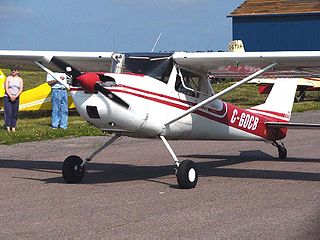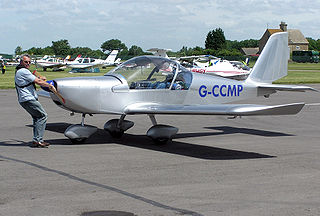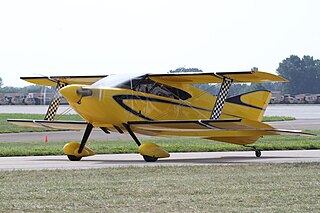
The Sorrell SNS-7 Hiperbipe is a two-seat, negative stagger, conventional landing gear-equipped cabin biplane designed for amateur construction that was produced in kit form by Sorrell Aviation of Tenino, Washington and since 2015 by Thunderbird Aviation.

The Stolp Starduster Too SA300 is a two-seat, conventional landing gear equipped homebuilt biplane. Aircraft Spruce & Specialty Co currently holds rights to sell plans for the aircraft.

The St-Just Cyclone, also called the St-Just Cyclone 180, is a Canadian homebuilt aircraft that was designed and produced by St-Just Aviation of Mirabel, Quebec. The company has since moved to Boucherville, Quebec. While it was available the aircraft was supplied as a kit and in the form of plans for amateur construction.
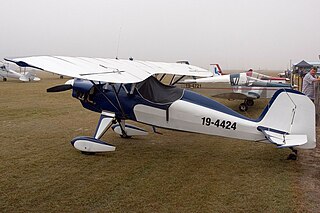
The Stolp SA-500 Starlet is an American amateur-built aircraft. The aircraft is supplied in the form of plans for amateur construction by Aircraft Spruce & Specialty of Corona, California.

The Rihn DR-107 One Design is an American aerobatic homebuilt aircraft that was designed by Dan Rihn and first flown in 1993. The aircraft is supplied by Aircraft Spruce & Specialty of Corona, California in the form of plans and a materials kit for amateur construction.
The Giles G-200 is an American aerobatic homebuilt aircraft that was produced by AkroTech Aviation of Scappoose, Oregon. When it was available the aircraft was supplied as a complete ready-to-fly-aircraft or a kit for amateur construction. AkroTech Aviation went out of business and the design is no longer in production.
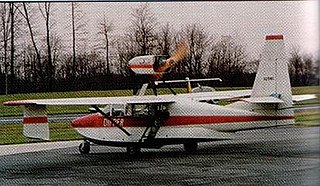
The Collins Dipper was an American homebuilt flying boat that was designed and produced by Collins Aero of Chadds Ford, Pennsylvania and first flown in 1982. The aircraft was supplied in the form of plans for amateur construction. Only one was built and none remain registered.

The Culp Special is an American aerobatic homebuilt aircraft designed and produced by Culp's Specialties of Shreveport, Louisiana. The aircraft is supplied as a kit or in the form of plans for amateur construction.
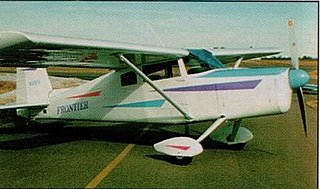
The Frontier MD-II was an American homebuilt aircraft that was designed and supplied as a kit by Frontier Aircraft Inc of Vail, Colorado, introduced in the 1990s.
The Henderson Little Bear is an American homebuilt aircraft that was designed and produced by Henderson Aero Specialities of Felton, Delaware, introduced in 1993. The aircraft is a replica of the Piper J-3 Cub. When it was available the aircraft was supplied as a kit or in the form of plans for amateur construction.
The Javelin V6 STOL is an American STOL homebuilt aircraft that was designed and produced by Javelin Aircraft of Wichita, Kansas. When it was available the aircraft was supplied in the form of plans for amateur construction.
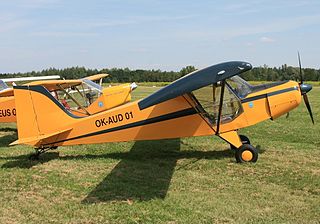
The Let-Mont Tulak is a Czech microlight aircraft that was designed and produced by Let-Mont sro of Vikýřovice. When it was available the aircraft was supplied as a complete ready-to-fly-aircraft or a kit for amateur construction.
The Progressive Aerodyne Stingray is an American homebuilt flying boat that was designed by and produced by Progressive Aerodyne of Orlando, Florida, introduced in the 1990s. When it was available the aircraft was supplied as a kit for amateur construction.

The Reflex Lightning Bug, also called the Jones Lightning Bug, is an American homebuilt aircraft that was designed by Nick Jones and produced by Reflex Fiberglass Works of Walterboro, South Carolina, introduced in the mid-1990s. When it was available the aircraft was supplied as a kit for amateur construction.

The SkyDancer SD-260 was an American aerobatic Homebuilt biplane that was designed and produced by SkyDancer Aviation of Louisville, Kentucky, introduced in the mid-1990s. When it was available the aircraft was supplied as a kit.
The Starfire Firebolt, sometimes called the Starfire Firebolt Convertible, due to its removable canopy, is an American homebuilt aerobatic biplane that was designed by G. H. "Mac" McKenzie and produced by Starfire Aviation of Tempe, Arizona. When it was available the aircraft was supplied in the form of plans for amateur construction, with some pre-fabricated parts available.
The Ultimate 10-200 is a Canadian homebuilt aerobatic biplane that was designed produced by Streamline Welding of Hamilton, Ontario, introduced in the 1990s. When it was available the aircraft was supplied as a kit or in the form of plans for amateur construction.
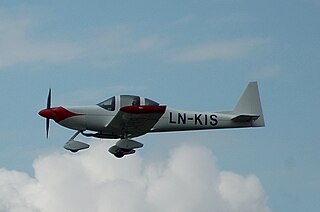
The Tri-R KIS TR-1 is an American homebuilt aircraft that was designed by Rich Trickel and produced by Tri-R Technologies of Oxnard, California, introduced in the 1990s. When it was available the aircraft was supplied as a kit for amateur construction.
The V-STOL Super Solution 2000 is an American STOL homebuilt aircraft that was designed by Dick Turner and produced by V-STOL Aircraft Corporation of Fort Myers, Florida. When it was available the aircraft was supplied as a kit for amateur construction.
The American Homebuilts John Doe is an American STOL homebuilt aircraft that was designed by Steve Nusbaum and produced by American Homebuilts of Hebron, Illinois, first flown in 1994. When it was available the aircraft was supplied as a kit for amateur construction.




